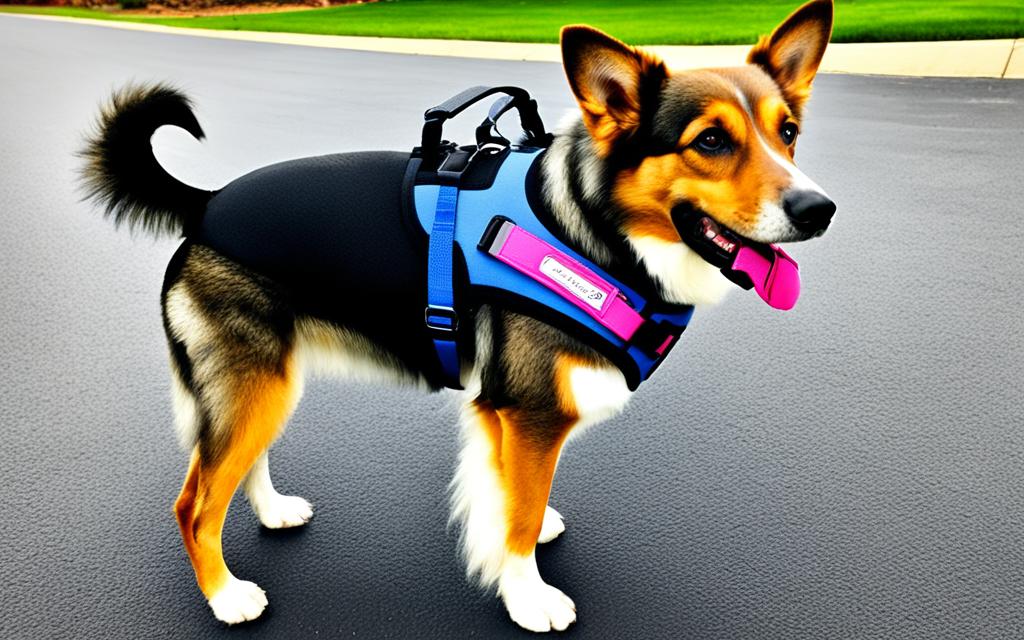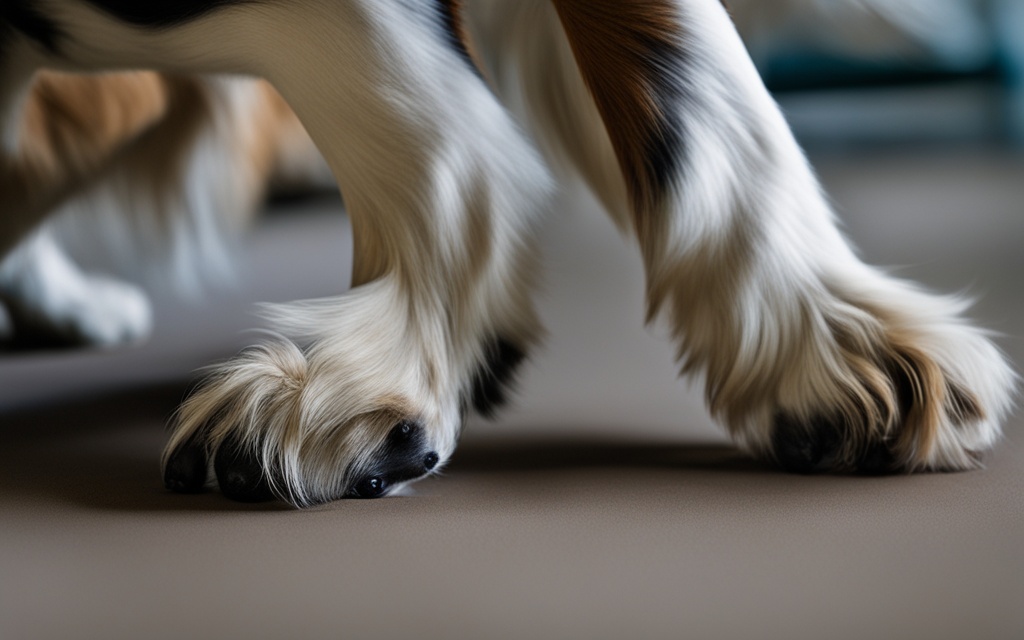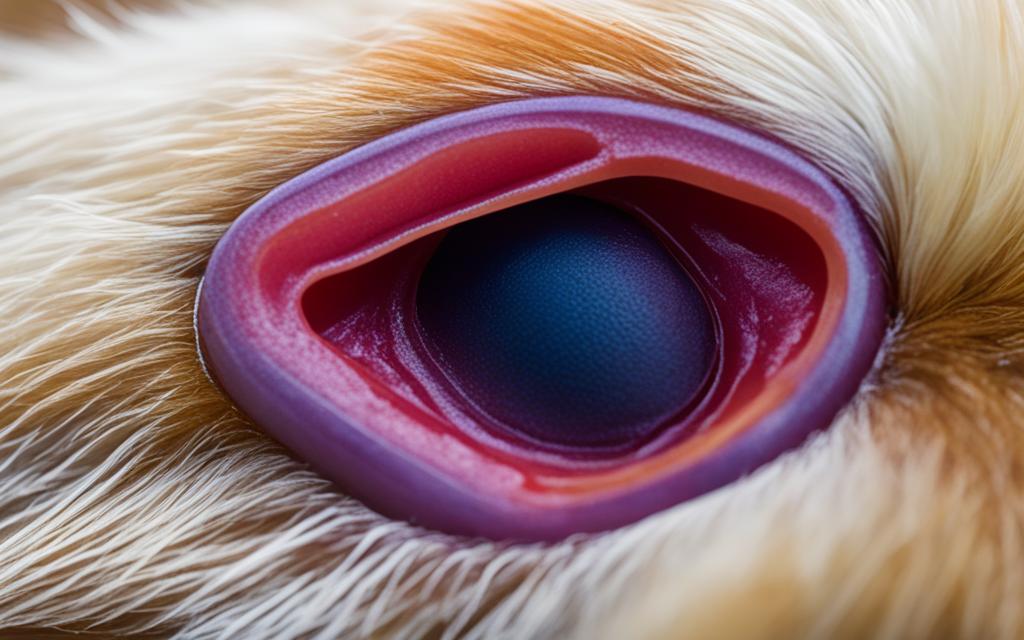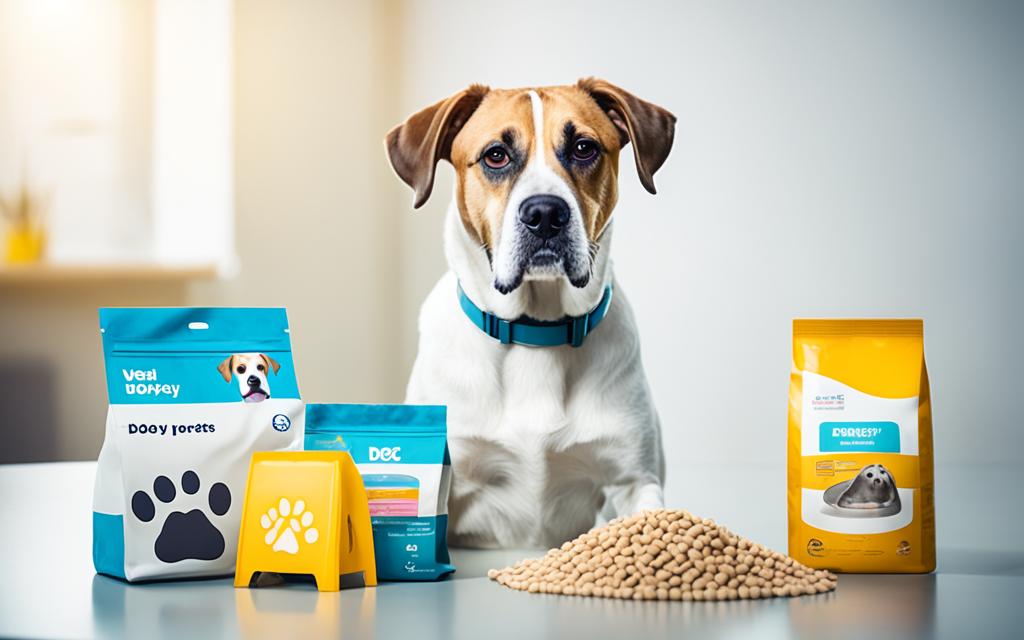Canine hip dysplasia is a common issue in many dogs. It happens when the hip joint doesn’t form right, causing pain and trouble moving. It’s important for dog owners to know about it because catching it early can help a lot.
Spotting the signs of canine hip dysplasia early is key. This means your pet can get the right help faster. We’ll look into what causes it, how to diagnose it, and what treatments are out there. This will help keep your dog happy and healthy.
Understanding Canine Hip Dysplasia
Canine hip dysplasia (CHD) is a genetic issue that affects dogs’ hip joints. It’s a type of developmental disorder. The hip joint’s structure is key here, as it doesn’t fit right, causing instability. This leads to arthritis and a lot of pain over time.
A normal hip joint has the femur’s head fitting well into the pelvis’s acetabulum. But with CHD, the joint might be misshapen or too loose. This causes odd movement patterns. These issues can get worse, making it hard for dogs to move, run, or do everyday activities.
Knowing about canine hip dysplasia helps us see how important the hip joint is for dogs’ health and movement. Catching it early and treating it can really help dogs feel better.
What Causes Canine Hip Dysplasia?
Canine hip dysplasia is caused by both hereditary and environmental factors. Knowing these causes helps pet owners prevent it and care for their dogs better.
Genetic Factors
Hereditary hip dysplasia has a big genetic part. Some dog breeds are more at risk because of their genes. German Shepherds, Golden Retrievers, and Rottweilers often get it more because of breeding that focuses on looks over health. This selection leads to more health problems, like hip dysplasia. Health registries for breeds can show which genes are linked to this issue.
Environmental Influences
Environmental factors are key in hip dysplasia. A dog’s diet affects their weight and health. So, feeding them right and keeping them at a healthy weight is crucial for their hips.
Puppies growing too fast can also lead to hip dysplasia. Bad nutrition during this time can hurt their joints. Too much or too little exercise can make things worse. It’s important to exercise them right, as advised by vets, for strong joints.
| Factor | Description |
|---|---|
| Genetic Predisposition | Certain breeds have a higher risk due to genetics. |
| Purebred Dog Risks | Selective breeding can lead to hereditary hip dysplasia. |
| Canine Diet | A balanced diet aids in preventing obesity in dogs. |
| Environmental Factors | Impact of exercise and nutrition on hip joint health. |
| Obesity in Dogs | Excess weight can increase stress on hip joints. |
Common Symptoms of Canine Hip Dysplasia
Knowing the canine hip dysplasia symptoms is key for early help. Dogs show several signs that they might have hip problems. These signs can lead to worse conditions if not caught early. Spotting these symptoms early helps owners get their pets the right vet care.
Limping and Lethargy
A common sign of hip problems is dog limping. This can be a slight limp or a more obvious uneven walk. It often comes with canine hip pain making the dog less energetic and less interested in play or exercise. Dogs might choose to rest more than they used to, which is a big sign they could be in pain.
Difficulty in Movement
As hip dysplasia gets worse, dogs have trouble moving around. They might find it hard to climb stairs or jump up onto furniture. Even simple activities like playing fetch or running become tough. Over time, these joint problems can make it hard for dogs to move around, hurting their quality of life.
| Symptom | Description | Recommended Action |
|---|---|---|
| Dog Limping | Noticeable limping in one or more legs | Seek veterinary evaluation |
| Lethargy | Reduced activity levels and interest in play | Monitor behavior; consult a vet if persistent |
| Difficulty in Movement | Struggles with stairs, jumping, or running | Assess mobility; discuss options with a veterinarian |
These symptoms suggest canine hip dysplasia. Catching it early and getting help can make a big difference for dogs.
Diagnosis of Canine Hip Dysplasia
Diagnosing canine hip dysplasia starts with a detailed vet check to look at the dog’s health. The first step is a clinical examination. Vets check how the dog moves and look for signs of pain or odd movement. This helps spot possible hip problems early.
Veterinary Examination
Vets check several things during a vet check for hip dysplasia, like:
- Physical mobility and range of motion.
- Signs of pain or stiffness in the hip joints.
- Assessment of the dog’s gait and posture.
This helps the vet make a better diagnosis. They look at genetics and environmental factors too. These can make joint problems worse over time.
Imaging Techniques
After the clinical exam, imaging is the next step. X-rays are often used to check the hip joints. They show if there are any problems. Canine radiology helps see how bad the dysplasia is and plan treatment.
Advanced scans like CT and MRI might be used if needed. They give a closer look at the hips.
By using both physical checks and imaging, vets can fully understand the condition. This leads to a precise diagnosis of canine hip dysplasia.
Canine Hip Dysplasia: Causes and Treatment Options
Understanding canine hip dysplasia is key to finding the right treatment. It comes from both genes and lifestyle. Vets say treatment should match the dog’s age, breed, and how bad the symptoms are.
Dealing with hip dysplasia means using medicine and changing how you live. Owners can try:
- Nonsteroidal anti-inflammatory drugs (NSAIDs) for pain relief
- Weight management to reduce stress on the joints
- Physical therapy aiding in mobility and strength
Other treatments like acupuncture or hydrotherapy can also help. It’s important to see the vet often to check on the dog and change the treatment if needed.
The goal is to make the dog’s life better and lessen pain. Managing hip dysplasia well means working together with vets to take care of everything the dog needs.
| Treatment Option | Description | Pros | Cons |
|---|---|---|---|
| Medication | Use of NSAIDs and pain medications | Reduces pain and inflammation | Potential side effects with long-term use |
| Physical Therapy | Exercises to improve strength and flexibility | Enhances joint function | Requires commitment and regular sessions |
| Surgery | Procedures like hip replacement or corrective surgery | May provide long-term relief | Involves risks and recovery time |
| Weight Management | Diet and exercise to maintain ideal weight | Reduces joint pressure | Requires consistent lifestyle changes |
Treatment Options for Canine Hip Dysplasia
Canine hip dysplasia can make dogs very uncomfortable. Treatments that focus on easing pain and helping them move better are key. Knowing what options are out there can make your dog’s life better.
Medication and Pain Management
Managing pain in dogs with hip dysplasia often means using different medicines. Non-steroidal anti-inflammatory drugs (NSAIDs) are commonly used to help with pain. Corticosteroids can also reduce swelling and help with pain. Some people are looking into supplements as extra ways to help with pain.
It’s important to talk to a vet before giving your dog any medicine for hip dysplasia. They can tell you the right amount to give and what might be bad for your pet.
Physical Therapy
Physical therapy is a great way to help dogs with hip dysplasia without surgery. These programs use exercises to make the muscles around the hip stronger. This helps your dog move better and feel better overall.
Some of these exercises include underwater treadmill work, laser therapy, and special stretches. Many dogs have gotten better and hurt less after going through a rehab program.

| Medication Type | Purpose | Considerations |
|---|---|---|
| NSAIDs | Pain relief for dogs and inflammation reduction | Regular vet check-ups required |
| Corticosteroids | Reduce inflammation | Monitor for potential side effects |
| Supplements | Support joint health | Consult with a vet before use |
| Physical Therapy | Improve mobility and strength | Engage qualified pet therapists |
Surgical Interventions for Severe Cases
When canine hip dysplasia gets worse, surgery is often the best option for getting your dog moving again and feeling better. There are two main surgeries: hip replacement and juvenile pubic symphysiodesis. Knowing about these can help you make the right choice for your pet.
Hip Replacement Surgery
Hip replacement surgery is a common solution for dogs with severe hip dysplasia. It means taking out the bad hip joint and putting in an artificial one. Studies show that this surgery can work well, making dogs much happier and more active.
After the surgery, your dog will need to follow a special recovery plan that includes physical therapy. They might need help for a few weeks to get stronger and move better. Many dogs end up doing things they loved to do before the surgery.
Juvenile Pubic Symphysiodesis
Juvenile pubic symphysiodesis is a surgery done on young dogs, usually before they are six months old. It changes the way the pelvic bone grows to keep the hip joint in the right place. This surgery can stop hip dysplasia from happening in some breeds.
Research shows that dogs who get this surgery early have fewer problems later on. The success of this surgery shows how important it is to catch hip dysplasia early for the best results.
Preventive Measures for Canine Hip Dysplasia
Preventing canine hip dysplasia means focusing on nutrition, weight, and exercise. It’s important for pet owners to understand how a healthy lifestyle can lower the risk of joint problems.
Proper Nutrition and Weight Management
Feeding your dog the right food is key to fighting hip dysplasia. The right diet helps keep your dog at a healthy weight, easing stress on their joints. Choosing meals with the right nutrients is crucial for your dog’s health. This approach helps prevent obesity and supports a long, comfortable life.
- Choose high-quality dog food that meets AAFCO standards.
- Consult with a veterinarian to tailor portion sizes to your dog’s needs.
- Monitor your dog’s weight regularly to avoid obesity.
- Incorporate supplements such as glucosamine and omega-3 fatty acids, if recommended.
Exercise and Activity Guidelines
Keeping your dog active is key to strong joints and avoiding weight gain. Exercise plans should fit your dog’s age and activity level. Regular, moderate exercise boosts overall health, keeping your dog physically and mentally sharp.
- Engage in daily walks suited to your dog’s endurance levels.
- Incorporate low-impact activities, such as swimming or gentle fetch.
- Balance exercise with rest periods to avoid overexertion.
- Utilize toys that encourage active play without causing strain.
By focusing on a balanced diet and regular exercise, pet owners can greatly reduce the risk of canine hip dysplasia. This approach improves your dog’s life quality. Consistent care in these areas leads to happier, healthier dogs.
Living with a Dog Suffering from Hip Dysplasia
Caring for a dog with hip dysplasia means making lifestyle changes to improve their life. Owners can help by making their home comfortable and following daily routines. These steps can make your dog feel better.
Home Care Tips
Start by making your home safe and supportive for your dog. Here are some important tips:
- Choose orthopedic bedding to cushion their joints.
- Create a safe space by removing obstacles that could cause slips or falls.
- Establish a consistent and moderate exercise routine to maintain mobility without causing discomfort.
- Incorporate gentle stretching exercises into their daily routine to promote flexibility and ease stiffness.
Supportive Equipment
Using the right gear can help your dog move better and feel more comfortable. Consider these tools and aids for dogs with hip dysplasia:
| Equipment | Description | Benefits |
|---|---|---|
| Slings | Assistive devices for lifting and supporting a dog when walking. | Reduces strain on joints during movement. |
| Harnesses | Specialized harnesses designed for dogs with mobility issues. | Improves stability and control while walking. |
| Orthopedic Beds | Beds designed to provide extra support for aching joints. | Enhances comfort and promotes better sleep. |

Choosing the right gear helps your dog stay mobile and comfortable. Investing in supportive gear for dogs with hip dysplasia can greatly improve their daily life.
Future of Canine Hip Dysplasia Treatment
The treatment for canine hip dysplasia is changing fast with new veterinary advancements. These changes are key for giving dogs with hip dysplasia a better life. New surgeries, regenerative medicine, and custom treatment plans are changing how we treat this condition.
Advances in Veterinary Medicine
Researchers are working on new solutions for pets with hip dysplasia. They’re using less invasive surgeries and biologics to help dogs heal faster and better. Stem cell therapy and platelet-rich plasma are showing great promise in regenerative medicine. This means vets can create treatments that fit each pet’s needs, making them more effective.
Research and Clinical Trials
Studies on pet health are very important. Clinical trials help develop and test new treatments for hip dysplasia. Pet owners can join these studies to help science and their pets. They get to try new therapies that could change their pets’ lives.
| Type of Advancement | Description | Benefits |
|---|---|---|
| Minimally Invasive Surgery | A surgical technique with smaller incisions | Reduced recovery time and less pain |
| Regenerative Medicine | Use of stem cells and biologics | Potential for healing and cartilage regeneration |
| Personalized Treatment Plans | Tailored approaches based on specific pet needs | Increased effectiveness and improved outcomes |
| Ongoing Clinical Trials | Research on new therapies and techniques | Access to cutting-edge treatment options |
Conclusion
Understanding hip dysplasia is key for dog owners. It’s important to catch it early and get the right treatment. If not treated, it can cause a lot of pain and make moving hard for your dog.
Regular vet visits help spot the problem early. They also help find the best way to treat it. This can really improve your dog’s life.
Knowing the signs of hip dysplasia is crucial. Taking your dog to the vet quickly can make a big difference. By focusing on your dog’s joint health, you help them stay happy and active.




